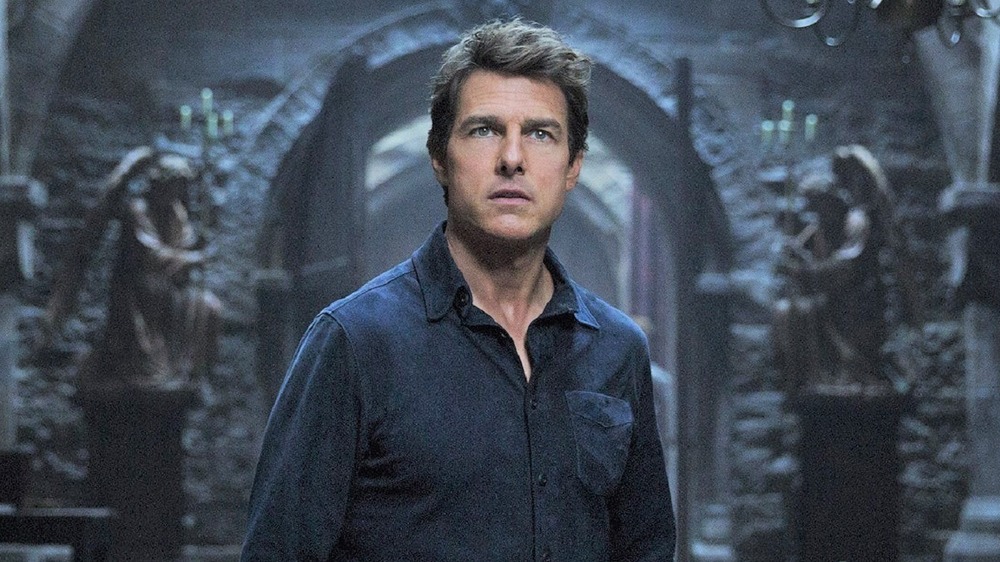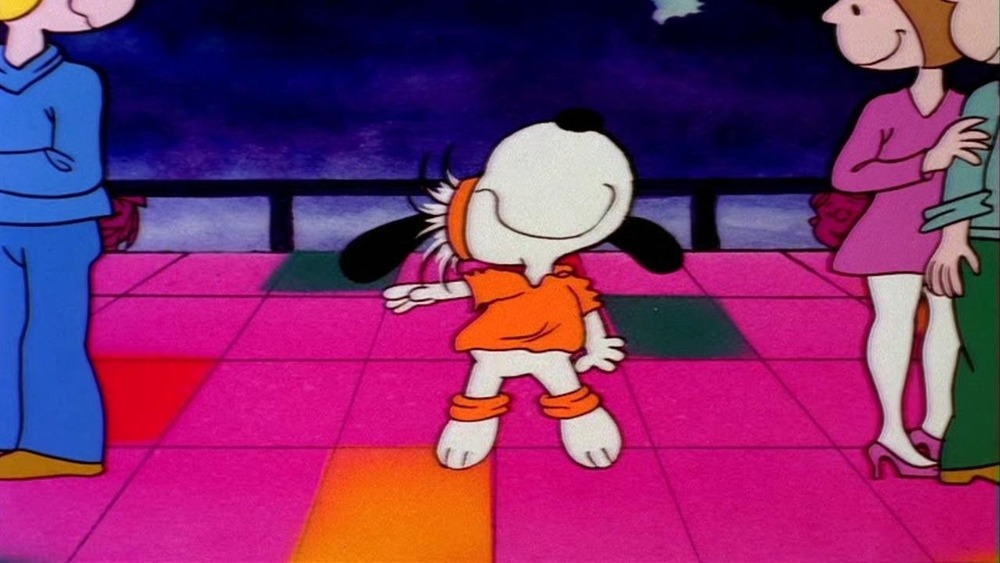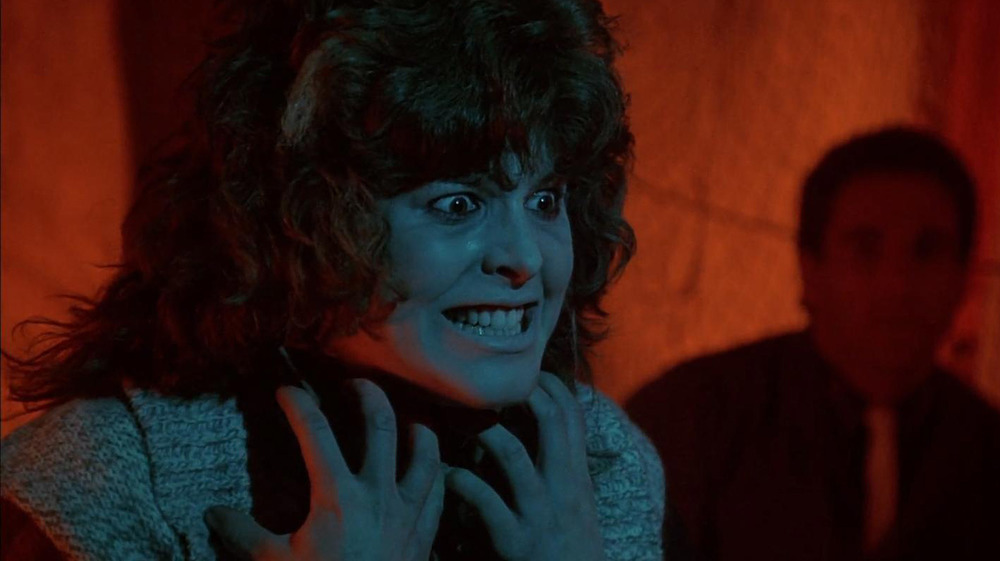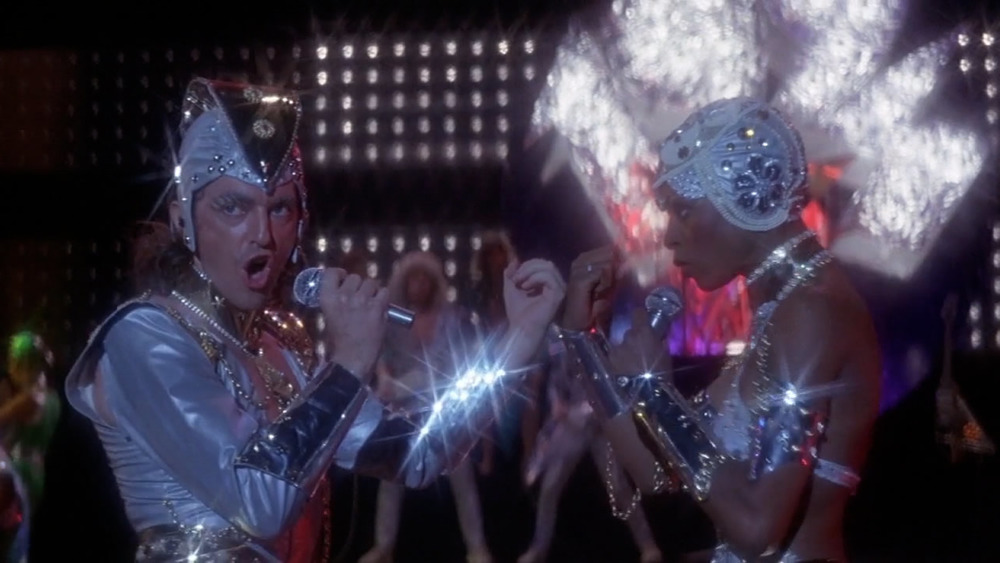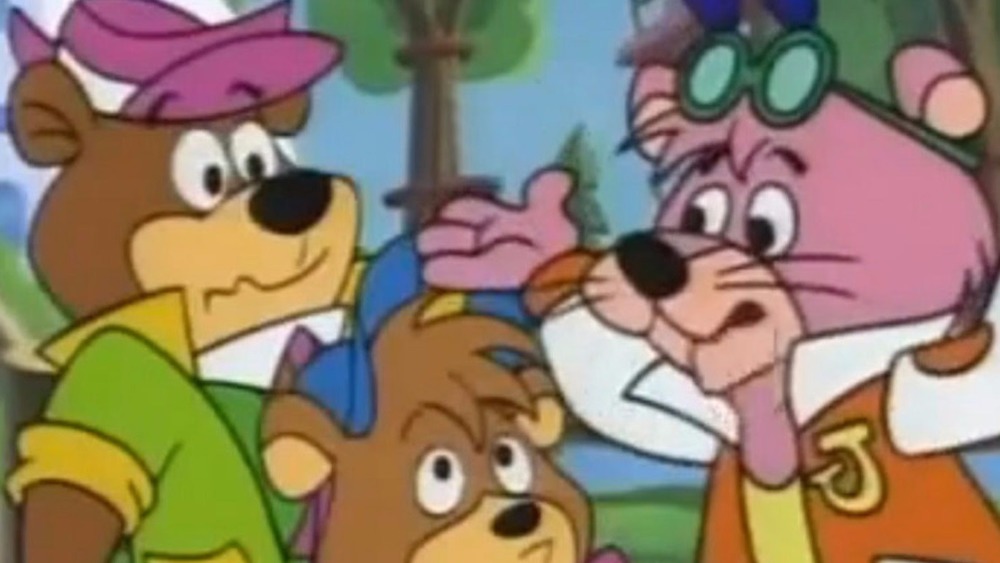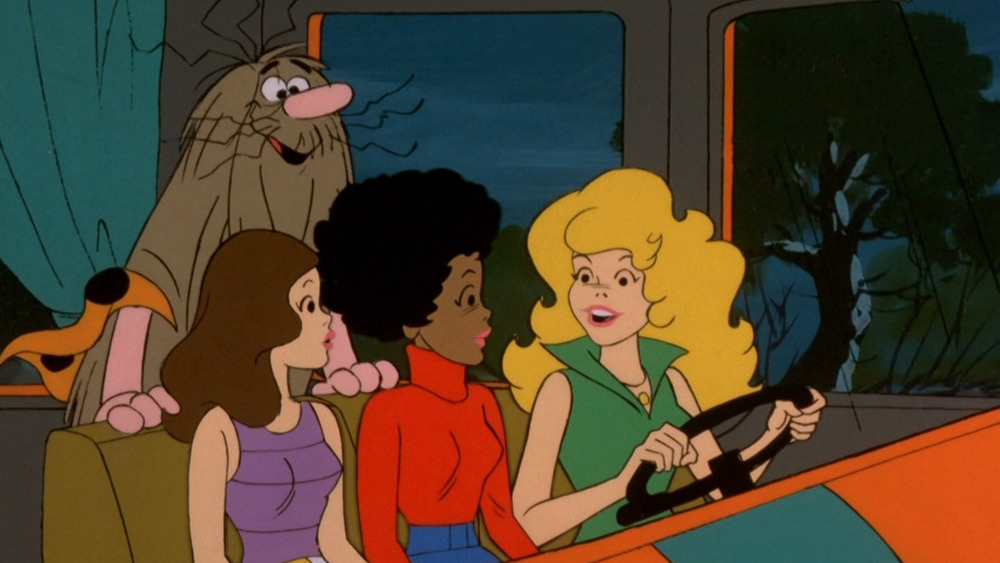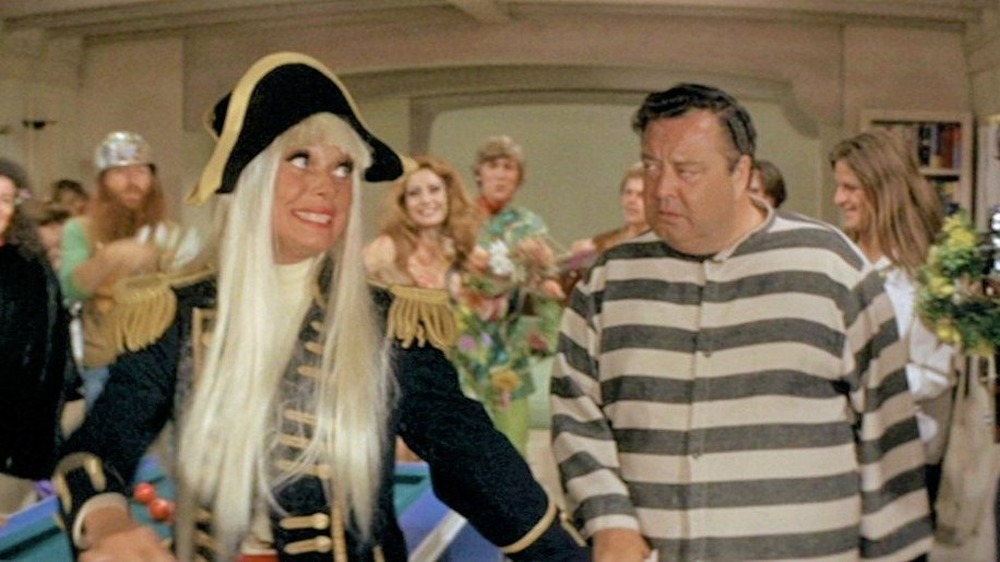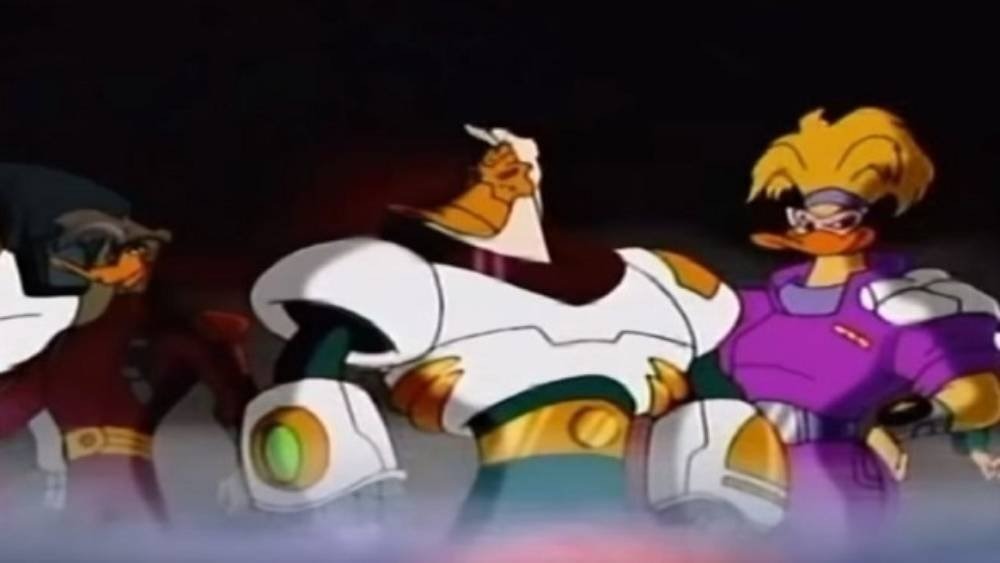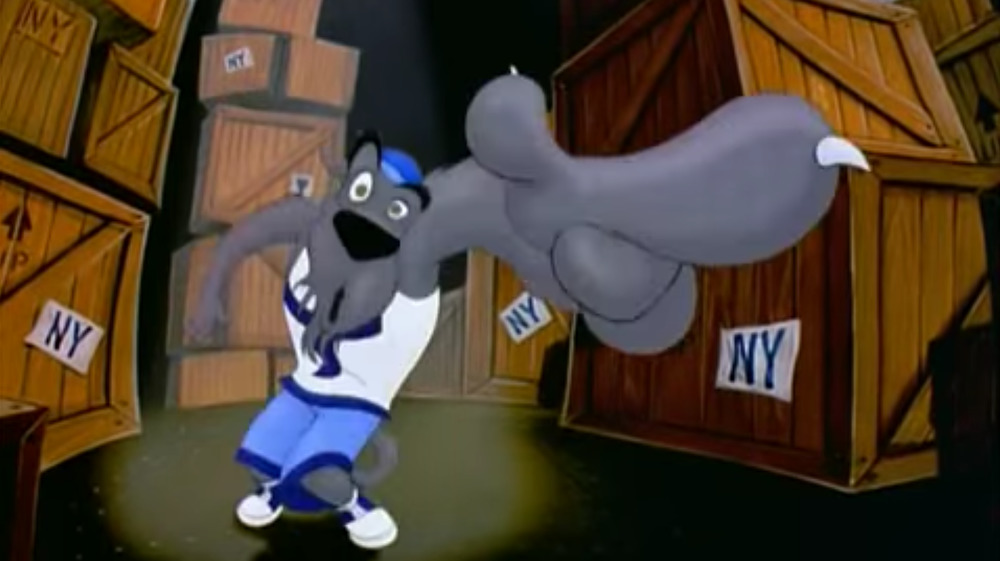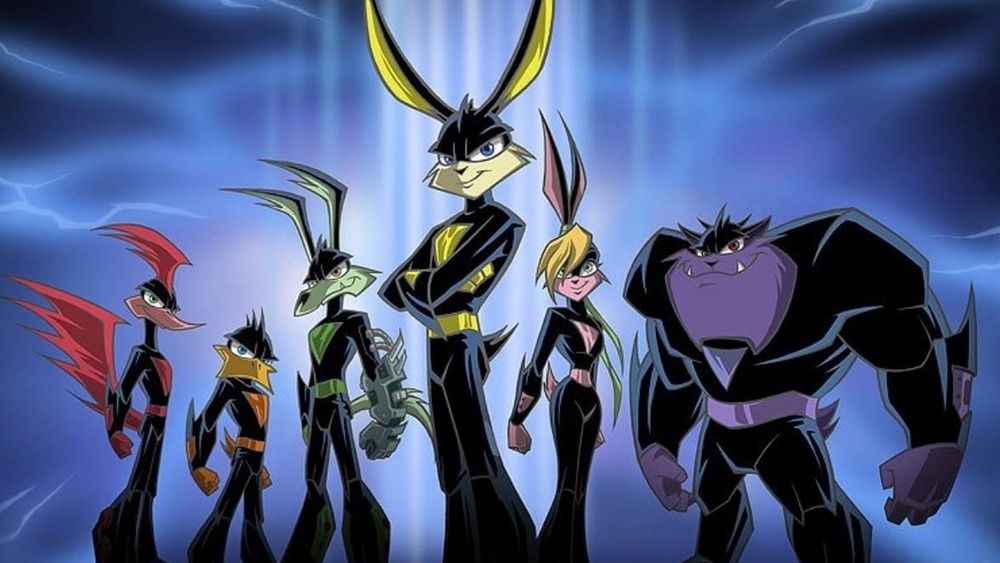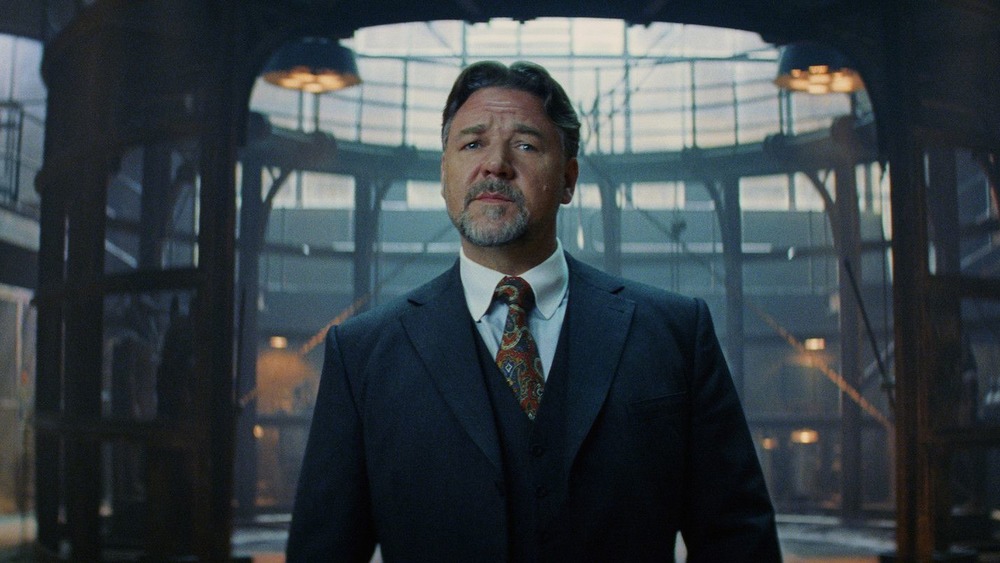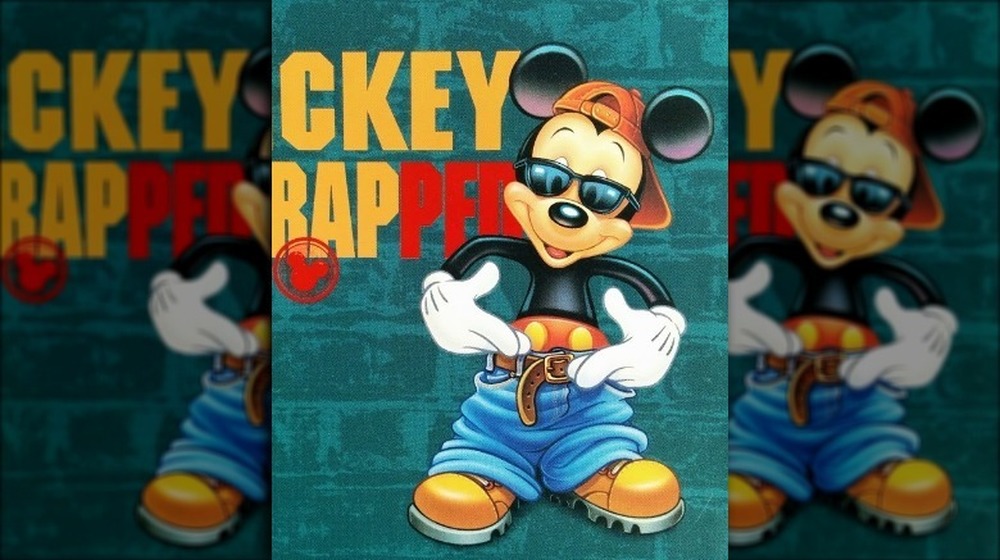The Most Embarrassing Attempts At Trend-Chasing In Movies And TV
What's better — to be timely or timeless? If you create a work of art totally detached from current fads, it might endure long after they're gone, but if not, you run the risk of looking old-fashioned. If you latch onto whatever's hot and popular in the moment, you might reinvigorate a brand that's in danger of being forgotten or ride the fad's popularity to your own success. But if you fail, you'll become a laughingstock. And the chances of failure become much higher when creators don't even understand why fads are popular in the first place.
That's the case with the movies and TV shows on this list. Every media mogul wants the attention of the lucrative but fickle youth audience. Trouble is, most of those moguls haven't been youth themselves for a very long time. And they often try to apply the fads of the day to franchises that are at least as old themselves, some of them so antiquated that just the idea of updating them is downright hilarious. For every movie and show that perfectly captures the zeitgeist, there are hundreds that tried and fell flat on their faces. Here are just a few of them.
It's Flashbeagle, Charlie Brown! was Peanuts' least timeless moment
Few franchises in any media have the timeless appeal of Charles Schulz's Peanuts. Even though they've been running since the '50s, Schulz captured something essential about childhood that hasn't changed, even with the rise of smartphones and the internet. It's a world outside history, combining the experiences of generations of readers with his own childhood decades earlier.
But nobody's perfect, and Peanuts' timeless charm has one very notable exception. In 1983, Jennifer Beals starred in the smash hit Flashdance, a film about a woman who welds steel by day and dances in legwarmers by night. It's about as '80s as anything you could name, but for whatever reason, it struck Schulz and his animated adapter, Bill Melendez, enough to make a whole TV special.
It's nothing short of surreal to see Snoopy dancing in a headband-and-legwarmer combo to ear-bleeding synths. The presence of fully visible adults, which most Peanuts specials went out of their way to avoid, doesn't help one bit. Peanuts was never big on plot, but It's Flashbeagle makes A Charlie Brown Christmas look like a David Fincher thriller, ping-ponging from a trendy aerobics class and a house party to Snoopy's night on the town and Sally Brown's school show-and-tell with no rhyme or reason. Peanuts Christmas and Halloween specials have aired every year since they debuted, but It's Flashbeagle's faddishness left it on the ash heap of history. We're probably better off that way.
Ninja III: The Domination tried to get in on every trend at once
Israeli-American producers Menahem Golan and Yoram Globus never met a fad they couldn't squeeze money from, and in Ninja III: The Domination, they loaded up a film with a whole truckload of them, never mind that they had no business appearing in the same movie. Ninja III's heroine, Christie, isn't a steelworker, but she is an electrician, and she may not dance at a bar, but she does wear Jennifer Beals' Flashdance getup to her second job in the trendy world of aerobics instruction. As if that wasn't enough, Ninja III combines that plot with martial arts action and a bald-faced Exorcist ripoff when Christie is possessed by a dying ninja who massacres a golf course full of country clubbers and cops for reasons we never actually learn.
No one could accuse Golan and Globus of failing to keep up with trends, but they didn't do much diligence in following them beyond the surface level. Just look at Christie's bizarrely '80s-tastic apartment, which is bigger than most people's whole houses and includes such dated decor as a Patrick Nagel print and a video game console. And yes, we mean one of those huge monsters you'd normally only see in an arcade. The filmmakers apparently heard people liked playing video games at home but hadn't bothered to check who was playing them or how, giving their athletic heroine the tastes of a 12-year-old boy and the equipment of a shopping mall.
The Apple predicts the future will look like Studio 54
The Apple is a masterpiece of misguidedness, another product of the Golan-Globus fever dream factory. This biblical sci-fi musical imagines that the future world of 1994 will follow the trajectory of the disco and glam rock styles that were already dying out on its release in 1980. Everything's coated in Mylar and glitter in this future world, ruled by Mr. Boogalow, the satanic CEO of Boogalow's International Music (BIM) who hopes to mold earnest folkies Alphie and Bibi in his own image. They're obviously supposed to represent authenticity in the face of Boogalow's soulless pop machine, but their painfully white soft rock is just as soulless. At least Boogalow's acts have the courtesy to be listenable. In one of the movie's most accidentally hilarious moments, an audience member is moved to tears by lyrics that go, "La la la la la."
Then again, the rest of the songs aren't much better. They were originally written in Hebrew and does it ever show. Apparently, co-composer George Clinton (not the cool one) just gave up on adapting the lyrics since so many are just the title over and over again, especially "BIM's on the Way," which is just those four words repeated until you're ready to cut your ears off with a chainsaw. That song, by the way, is the soundtrack for the "Daily BIM Hour," where everyone is mandated to drop whatever they're doing and dance to it for "exercise," just in case you need to know the level of wackiness we're dealing with.
Yo Yogi! tried to make a decades-old cartoon hip with '90s kids
In 1991, Hanna-Barbera tried to update their classic stable (heh) of animal characters like Yogi Bear, Huckleberry Hound, and Snagglepuss as hip teens hanging out at the Jellystone Mall. Trouble is, Bill Hanna and Joseph Barbera already came from an earlier generation of animators, as they were the creators of Tom and Jerry, and their vaudevillian, theatrical style was already an anachronism in the '50s and '60s, let alone the '90s.
Add to that their reliance on celebrity impressions to create characters, and you have the added surrealism of the voices of Andy Griffith, The Honeymooners' Ed Norton, and The Wizard of Oz's Cowardly Lion coming out of totally '90s teens, and you should get an idea of why Yo, Yogi! only lasted one season. And we haven't even gotten into their attempt to combine their classic character Magilla Gorilla with fading hip hop star Vanilla Ice as Magilla Ice — yes, Magilla Ice.
Like most of the creators on this list, the folks at Hanna-Barbera didn't even seem to understand the kids they were courting. One of Yo, Yogi's few original characters is Roxie Bear, who looks like a pierced-up punk but has a voice straight out of Frank Zappa's "Valley Girl." Punks and preppies aren't the same — they're natural enemies, like bears and park rangers!
Hanna-Barbera really wanted a kid-friendly Charlie's Angels
Charlie's Angels may not seem like a logical place to go for inspiration for kiddie programming. Years before Kristen Stewart or Lucy Liu took the Angels to the big screen, the original series was labeled "jiggle television," giving straight male viewers as good of a look at the bodies of Farrah Fawcett and her costars as Standards and Practices would allow.
But go to it Hanna-Barbera did, not once but twice, and they didn't even try to hide it, creating two series with similar premises and very similar names. Captain Caveman and the Teen Angels used the Charlie's formula, replacing their unseen backer with an unfrozen, hairy Neanderthal voiced by Looney Tunes' Mel Blanc with his best Yosemite Sam bellow. Even stranger was Casper and the Angels. This show didn't just combine Charlie's Angels with the classic friendly ghost from the Famous Studios cartoons and Harvey Comics. It took them to outer space! (Surprisingly, this space ghost never met Hanna-Barbera's more famous Space Ghost.) That decision makes more sense when you remember what else was big when Casper and the Angels debuted in 1979, as it was just two years after Star Wars smashed box office records. Why rip off one competitor when you can go for two at a time?
Skidoo tried to bring Old Hollywood's biggest stars into the '60s
The year 1968 was a strange, strange time in Hollywood history. Just one year before, the success of movies like The Graduate and Bonnie and Clyde proved the studios needed to appeal to a new, younger audience if they wanted to survive. The trouble is, no one seemed to know just what the kids wanted.
No one knew less than the cast and crew of Skidoo. At a time when kids said not to trust anyone over 30, the primary cast of Skidoo was over 40 at least, from the great 1930s comedian Groucho Marx to Broadway legend Carol Channing to Honeymooners star Jackie Gleason. The only genuine hippie onboard was rock star Harry Nilsson, whose halfhearted contributions to the soundtrack — including singing all the credits — sound more like children's music than rock 'n' roll.
The plot tries to show the triumph of the hippies over the establishment even though it's made by the establishment and doesn't particularly seem to like or understand the hippies it's pandering to. Even the title is a reference to 30-year-old slang. G. Smalley mentions in his hilarious review that director Otto Preminger really did sample acid for research, but it's hard to believe. Odd as it is to say, the interminable trip scenes are too weird, with images like Groucho Marx's head on top of a screw and the plot stopping dead while two prison guards watch dancing trash cans.
In the '90s, everyone wanted to be a Ninja Turtle
In what we can only assume is some kind of cosmic prank, a self-published black-and-white comic book became one of the most inescapable multimedia franchises of the '80s and '90s. Teenage Mutant Ninja Turtles was everywhere, and that meant everybody and their mother wanted a piece of the action. The airwaves and toy racks were crammed full of "cool but rude" musclemen with animal heads, from Street Sharks to C.O.W.-Boys of Moo Mesa to SWAT Kats to Biker Mice from Mars.
Even Disney wasn't above the fray, mutating their Mighty Ducks hockey movies into a bizarre TV cartoon about superpowered alien duck-people fighting evil intergalactic lizards — and still playing hockey, for some reason. Fish Police at least gets credit for going back to the source and adapting another self-published black-and-white comic book, but it loses points for trying to rip off two franchises at once by attempting to muscle in on The Simpsons' turf as a prime-time cartoon. Either way, it failed. Fish Police crashed and burned after only three episodes.
But even that can't compare to the failure of Battletoads. Adapted from a beat-'em-up video game, Battletoads lurched on to screens with a pilot that was never picked up and was released as a standalone special instead. If you thought the "cowabunga"-ing Ninja Turtles were dated and cheesy, just wait until you hear the Battletoads say "psychotronic," "cosmoriffic," and "geekomatic" within ten seconds. They also say "toadalicious," whatever that means.
Titanic: The Legend Goes On combined Disney-style musicals with a real-world tragedy
In the '90s, Walt Disney Animation was back on top after decades in the wilderness, impressing audiences with a winning formula of fairy-tale romance, big-eyed heroines, and wacky animal sidekicks. As a result, Saturday Night Live gave them and the record-smashing hit Titanic a little ribbing with the animated parody "Titey." The joke was obvious — no one would ever make a cartoon comedy out of such a tragic disaster, right?
Well, somebody did. In 2000, an Italian studio released Titanic: The Legend Goes On, which is less interested in tragedy than ripping off James Cameron's blockbuster ... and every animated movie ever made. In this film, the Titanic is populated by the mouse family from An American Tail, Cinderella, her stepmother and stepsisters, half the cast of 101 Dalmatians, and a dog ... who raps ... in 1912. You'll love The Legend Goes On if your idea of entertainment is people screaming and throwing stuff at you for an hour, and it was apparently edited by throwing the film into an industrial fan.
It's hard to imagine anyone else could have such a terrible idea, but another Italian studio released The Legend of Titanic, which may be even worse since it opens with an old mouse promising to tell the true story of the Titanic, in which exactly zero people die thanks to a giant pink octopus, and the wreck was the fault of a gang of evil sharks. And somehow, this one was successful enough to get a sequel!
Loonatics Unleashed made Bugs Bunny and company extreme!
Bugs Bunny and the rest of the Looney Tunes cast have been entertaining audiences almost as long as Mickey Mouse, but that doesn't mean their bosses won't continue trying to fix what, as Bugs might put it, ain't broke. That was definitely the case when Loonatics Unleashed debuted on The WB, which, in what we're sure is just a coincidence, folded the following year. In 2005, The WB updated the Looney Tunes crew for the '90s, with lots of scowly, smirky 'tude and the all-angles-everywhere style of Batman: The Animated Series. The "updated" character designs made some of the most iconic characters of all time look more like Sonic the Hedgehog also-rans.
Loonatics Unleashed brought viewers into the future, where an asteroid crash-lands on the "city-planet" Acmetropolis, giving superpowers to Ace and Lexi Bunny, Danger Duck, Rev Runner, Tech E. Coyote, and Slam Tasmanian. The show tried to combine a wide variety of genres that have no business being together, from mid-century slapstick to cyberpunk to Japanese anime to American superheroes. The result, as you might expect, was a mess — too action-oriented to be funny and too wacky to take seriously as an action cartoon. Besides, none of the intentional jokes are half as funny as listening to the voice cast try to seriously read dialogue like, "These mutant techno-Vikings must have been frozen inside during an ice storm in their own dimension."
The Dark Universe tried to beat Marvel with monsters
After the success of The Avengers, every studio wanted its own cinematic universe. But most of them tried to skip to the final phase, focusing on the connections before they could get audiences excited about the individual pieces. And none of them crashed and burned quite as hard as the Dark Universe.
The plans began with Dracula Untold in 2014, with reshoots adding a present-day epilogue to set up Dracula's future appearances with the other monsters who'd appeared in Universal's classic horror movies of the '30s and '40s. But after Untold was critically and commercially savaged, Universal backtracked, announcing the Dark Universe would really begin in 2017 with The Mummy.
Before The Mummy was even out, Universal was heavily promoting "the beginning" of something huge. We were going to get Javier Bardem as Frankenstein! Johnny Depp as the Invisible Man! Instead, it was the ending. The Mummy shows what happens when you try to work backwards from The Avengers instead of forward from Iron Man, eating up the runtime by setting up Russell Crowe as Dr. Jekyll, a store-brand Nick Fury who works for the store-brand S.H.I.E.L.D., Prodigium, which is apparently the result of a contest to come up with the most portentous yet ridiculous name possible.
And The Mummy showed the flaws of trying to Marvelize monsters to begin with, focusing so much on superhero-style spectacle there was no room for horror. It's yet more proof that if you want to latch onto a trend, you'd darned well better learn why it's trendy first.
Mickey Mouse released music in every genre — no matter how inappropriate
Disney's original star is so valuable to them that the studio famously lobbied to rewrite copyright law to keep Mickey Mouse from entering the public domain. But if there was ever an argument that the general public can be better trusted with the character's stewardship than the Walt Disney Company, it's the series of bizarre albums they slapped his voice on.
The ball started rolling in 1979 with Mickey Mouse Disco, possibly because Disney realized nothing they did with Mickey and Donald could be worse than "Disco Duck." But they certainly tried, with a tracklist including disco remixes of "Zip-a-Dee-Doo-Dah" and "It's a Small World."
Totally Minnie created an unholy hybrid by combining Mickey's girlfriend with '80s pop stars like Cyndi Lauper and Madonna. In the TV special, a kid goes to get style advice from Mickey, Minnie, and friends (because who knows cool like 50-year-old cartoon animals?). He also meets Elton John and proves he's cool by returning to school dressed like him, even though Elton John's whole style can be described as "stuff no one else could pull off in a million years."
But nothing's quite as surreal as Mickey Unrapped, released at the height of hardcore gangsta rap's dominance of the genre with cover art showing Mickey Mouse dressed up like Tupac Shakur. Apparently, the fact that they had to airbrush out the "Thug Life" tattoo didn't make anyone realize what a bad idea this was.
